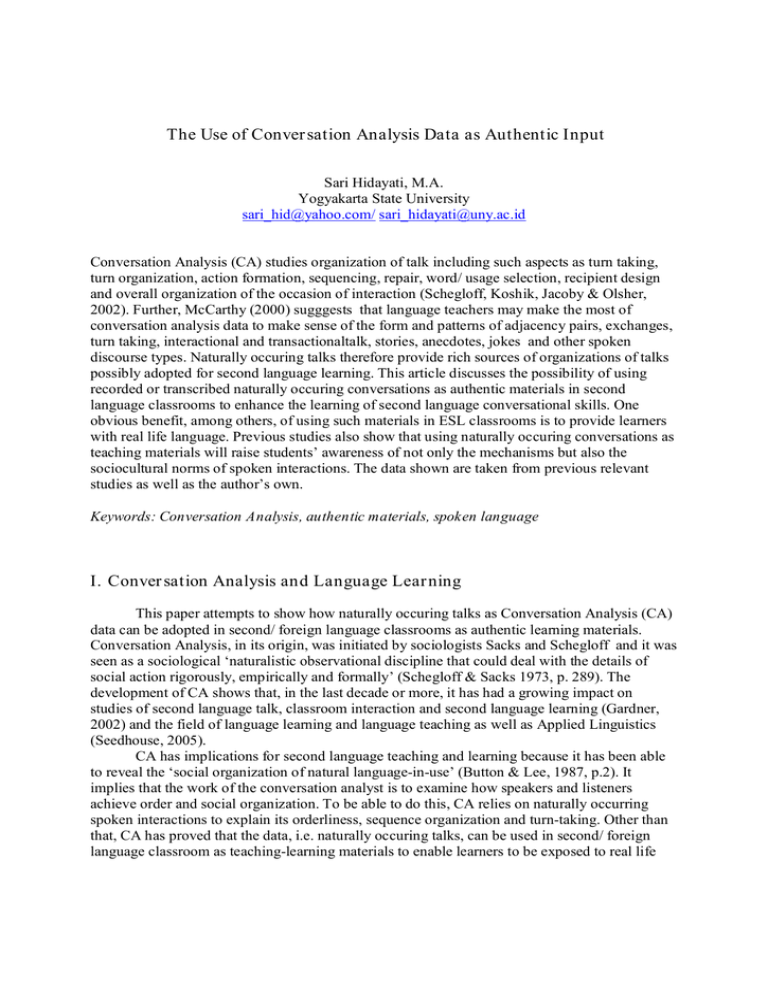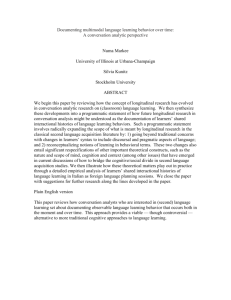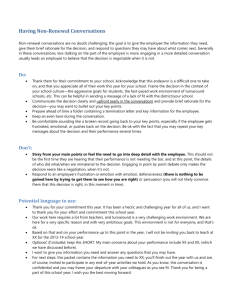The Use of Conversation Analysis Data as Authentic Input
advertisement

The Use of Conversation Analysis Data as Authentic Input Sari Hidayati, M.A. Yogyakarta State University sari_hid@yahoo.com/ sari_hidayati@uny.ac.id Conversation Analysis (CA) studies organization of talk including such aspects as turn taking, turn organization, action formation, sequencing, repair, word/ usage selection, recipient design and overall organization of the occasion of interaction (Schegloff, Koshik, Jacoby & Olsher, 2002). Further, McCarthy (2000) sugggests that language teachers may make the most of conversation analysis data to make sense of the form and patterns of adjacency pairs, exchanges, turn taking, interactional and transactionaltalk, stories, anecdotes, jokes and other spoken discourse types. Naturally occuring talks therefore provide rich sources of organizations of talks possibly adopted for second language learning. This article discusses the possibility of using recorded or transcribed naturally occuring conversations as authentic materials in second language classrooms to enhance the learning of second language conversational skills. One obvious benefit, among others, of using such materials in ESL classrooms is to provide learners with real life language. Previous studies also show that using naturally occuring conversations as teaching materials will raise students’ awareness of not only the mechanisms but also the sociocultural norms of spoken interactions. The data shown are taken from previous relevant studies as well as the author’s own. Keywords: Conversation Analysis, authentic materials, spoken language I. Conversation Analysis and Language Learning This paper attempts to show how naturally occuring talks as Conversation Analysis (CA) data can be adopted in second/ foreign language classrooms as authentic learning materials. Conversation Analysis, in its origin, was initiated by sociologists Sacks and Schegloff and it was seen as a sociological ‘naturalistic observational discipline that could deal with the details of social action rigorously, empirically and formally’ (Schegloff & Sacks 1973, p. 289). The development of CA shows that, in the last decade or more, it has had a growing impact on studies of second language talk, classroom interaction and second language learning (Gardner, 2002) and the field of language learning and language teaching as well as Applied Linguistics (Seedhouse, 2005). CA has implications for second language teaching and learning because it has been able to reveal the ‘social organization of natural language-in-use’ (Button & Lee, 1987, p.2). It implies that the work of the conversation analyst is to examine how speakers and listeners achieve order and social organization. To be able to do this, CA relies on naturally occurring spoken interactions to explain its orderliness, sequence organization and turn-taking. Other than that, CA has proved that the data, i.e. naturally occuring talks, can be used in second/ foreign language classroom as teaching-learning materials to enable learners to be exposed to real life language and situations. As CA data comprises conversations spoken in real life situations, using a CA-based materials implies using real life language and thus enabling learners to analyze the authentic situations. Research on CA have showed that CA has implications to second language teaching and learning in that CA data can be incorporated in second language classroom either as a pedagogical approach or teaching learning materials which offer real life language used in authentic situations. In employing CA-based pedagogical approach in second/ foreign language classroom, it is suggested that important second language interactional resources that both speaker and listener employ be made explicit. A study found that such a way can facilitate learning as learners can notice differences and similarities between first and second language (Mitchell & Myles, 1998). Using similar approach, Barraja-Rohan (2011) proves how CA data can be made use to teach learners interactional competence. The study shows that CA offers teachers insights into this interactional machinery, and they can then transfer this knowledge to second language students by making it explicit. Interactional features need to be taught in context through the use of recorded and transcribed naturally occurring conversations, which will form the basis of the lessons. She then suggests that the features of interactional competence relevant to second language students will depend upon their level of second language mastery and include the following (as cited from Barraja-Rohan, 2011, p. 481-482) 1. The turn-taking system, which involves how and when to take the floor, overlapping, the role of gaze and intonation, etc. The turn-taking system is also linked to the role of participants, either the primary speaker or secondary speaker (listener); 2. The sequential organization of utterances, which entails adjacency pairs. Adjacency pairs are connected to the preference organization system, such as preferred response (e.g. granting a request) or dispreferred response (e.g. refusing a request); 3. Actions performed by interactants. Interactants use talk to perform actions and orient to them, as for instance in the case of the adjacency pairs of greeting and leave-taking; 4. Repairs, i.e. being able to know when and how to initiate and accomplish a repair; 5. Intersubjectivity. How intersubjectivity is achieved, in other words how interactants make meaning to each other and display common understanding and knowledge; 6. Paralinguistic activities, which are produced purposefully and are therefore relevant and meaningful to the participants, such as pauses (e.g. the meaning of silence prefacing a dispreferred response as opposed to intraturn pause), intonation, gaze, gestures, perturbations (stuttering, hesitation markers, etc.), laughter, and others; 7. Context. Context is created by the participants, their utterances and actions, which reflect their relationship, e.g. how they address or greet each other. In brief, it is stated that as CA analyzes talk-in-interaction, it provides teachers with a structure of conversation and an approach to the teaching of interactional competence. Seedhouse (2005) stated that CA data are potentially used in Applied Linguistics areas, such as: teaching languages for specific purposes, language teaching materials design, language proficiency assessment, language classroom interaction, NS-NNS (native/non-native speaker) talk, and code-switching. In addition, CA research findings may also support Language for Specific Purposes curriculum, materials and assessment design. He further mentioned the settings that have been covered by CA studies which include legal hearings, news interviews, visits by health visitors, phone calls to emergency services and help lines, psychiatric interviews, airplane cockpit talk, mediation and counseling. To exploit CA data for the learning and teaching in the classrooms, specifically for those of Language for Specific Purposes classrooms, Jacoby (1998) suggests three ways as the following. First, it is suggested that CA data are extracted for pedagogical content and to infom learners of criteria for communicative success. Another way to make use of CA data in classroom is to bring in data samples to class for the students to observe, analyse and appreciate. Further, it is suggested that CA data can be used to compare commercial Language for Specific Purposes teaching materials with the reality observable in the data. The last suggestion implies the fact that what have been presented in commercially available materials might not authentically represent the real life language. Referring to the facts stated earlier, CA is seen to be in place to well picture the gap between dialogues contained in textbooks and naturally occuring interaction, in terms of both ordinary daily conversations and institutional interactions. Wong’s (2002) work is a clear example of how CA data were employed to describe the gap. Analyzing eight textbooks and specifically examining telephone dialogues containing in those books, Wong found that the examples of telepone dialogues did not satisfactorily fit with what conversation analyst describe about naturally occuring telephone dialogues. The identified four sequence types which typically occur in American English telephone conversations, namely summons–answer, identification– recognition, greeting and How are you? were not found in the examples of dialogues. In examining the presentation of thirty inauthentic phone conversations in ESL textbooks, Wong found that the above sequences were ‘absent, incomplete or problematic’ (2002, p. 37). It is then evidenced that CA research findings, such as the above sequence types, can support language teaching materials design. II. What Do Conversation Analysis Data Inform? A. Organization of Sequences Organization of sequences is grounds for adjacency pairs, which are inevitably connected to the preference organization system, such as preferred response, for example accepting an invitation, or dispreferred response, for example declining an invitation. There are two types of turns that are important for the understanding of relationship between talk and action, which are current and next turn. A current turn will determine the next turn being projected, which are made in the forms of analysis, appreciation or understanding of the previous turn. As illustration, a certain type of turns such as greeting, invitation will determine the next turns, which are made in the form of returning greeting, accepting or declining invitation. In Schegloff’s words : One of the most fundamental organizations of the practice for talk-in-interaction is the organization of turn taking. For there to be the possibility of responsiveness—of one participant being able to show that what they are saying and doing is responsive to what another has said and done—one party needs to talk after the other, and, it turns out, they have to talk singly. It is the organization of the practices of turn-taking that is the resource relied upon by parties to talk-in-interaction to achieve these outcomes routinely. (Schegloff, 2007, p. 1) Given the fact that the knowledge of organization of turn taking plays crucial role in achieving social order in conversation, CA data can then provide second/ foreign language classrom with information on how a conversation should be organized in accordance with the social functions. Below shows Schegloff’s illustration on sequence of telephoning conversations. From the above transcript, it is identified that naturally occuring telephone conversations comprise stages of sequences as summons–answer, identification–recognition, greeting and How are you? However, by analyzing eight textbooks and specifically thirty telephone conversations in the books, Wong (2002) found that the dialogues did not successfully picture organization of sequences as it is in real world situation. The results of Wong’s study show that none of the thirthy dialogues contain the four stages of sequences based on principles used in real life telephone convesations. The following is a transcript illustrating a dialogue that misses a summons-answer and thus resulting in ____________________ Wong p.15 Given that there is possibly a mismatch between organization of sequences in naturally occuring conversations and that in dialogues in textbooks, CA based materials are in place to bridge the gap. As CA data explicate orderliness, sequence and turn taking organization in naturally occuring conversations, using CA-based materials in classroom will expectedly build learners’ knowledge of sequence in conversation as structure of conversation. Also, such a material can equip learners with interactional skills of, for example, producing a coherent turn and adopting appropriate turn taking system in order to maintain intersubsectivity. An example of using CA-based materials in classroom aimed to build interactional skills, in terms of adopting adjacency pairs is seen in Baraja-Rohan’s (2011) transcript below. 1. Paul : 2. Jan : 3. Jan : 4. Jan : 5. Paul : 6. Paul : 7. Jan : 8. Paul : 9. Jan : 10. Paul: 11. Jan : 12. Paul: 13. Jan : hi Jan how are you↓ g’day Paul↓ I’m good↑ gee it was cold this morning though, wasn’t it↓ it was really hard getting out of bed↓ it certainly was↓ I really didn’t want to get out of bed and to work↓ no: still it is Friday↓ I know isn’t it great↑ [yeah↓ [and it’s supposed to be good on the weekend↑ the weather↑ yeah↑ barbeque weather↑ thirty degrees_ fantastic yeah, great↓ The conversation shows some resources of adjacency pairs of, among others, response tokens made by the two interactants, such as ‘I’m good’ (line 2) made as the response to ‘how are you’, and ‘it certainly was’ (line 5) as the response to utterance made by Jan in line 3 and 4. In addition, the transcript has been proved to provide learners with knowledge of sociocultural norm, which in this particular conversation is used in Australian context, as seen in response ‘g’day Paul’ in line 2. In brief, giving explicit explanation to learners about the ideas of adjacency pairs is very important as that will raise learners’ awareness on how to respond to certain prior utterance. B. Real life language As CA data are taken from real life conversations in authentic situations, it is argued that the data contain languages used in real life situations. As a consequence, using CA data in classroom will benefit learners in that they will be exposed to authentic languages used in target situations. As Wong (2002) found that the organization of sequences in textbooks is not matched with that in real life situations, this might also be the case with the expressions or languages used. Referring to the same transcript (Barraja-Rohan, 2011) discussed in the previous part, it can be seen that the conversation consists of some useful expressions to learn. 1. Paul : 2. Jan : 3. Jan : 4. Jan : 5. Paul : 6. Paul : hi Jan how are you↓ g’day Paul↓ I’m good↑ gee it was cold this morning though, wasn’t it↓ it was really hard getting out of bed↓ it certainly was↓ I really didn’t want to get out of bed and to work↓ 7. Jan : 8. Paul : 9. Jan : 10. Paul: 11. Jan : 12. Paul: 13. Jan : no: still it is Friday↓ I know isn’t it great↑ [yeah↓ [and it’s supposed to be good on the weekend↑ the weather↑ yeah↑ barbeque weather↑ thirty degrees_ fantastic yeah, great↓ In terms of vocabulary knowledge, given that the conversation takes place in Australian context, an expression of ‘g’day Paul’ (line 2) made as a response to a greeting ‘how are you’ (line 1) can be considered useful information on Australian sociocultural norms. The use of a question tag of ‘wasn’t it’ (line 3) is another resource that can be taught to learners as the alternate use of ‘yes’ or ‘right’, expressions chosen by Indonesian learners in general to be used in similar situation. The other response tokens made by the two interactants, such as ‘it certainly was’ (line 6), ‘no’ (line 7), ‘yeah’ (line 9, 11, 13), ‘fantastic’ (line 12) and ‘great’ (line 13), which show a sense of agreement, provide learners with alternate ways of expressing acknowledgement or agreement, which Indonesian learners likely say with ‘yes’ or ‘okay’. Particular attention might be given to a token of ‘no’ in line 7, which is made to agree with negative expression of ‘didn’t want’ in line 5. This pattern employs different rules from that in Bahasa Indonesia in which ‘yes’ is used to express agreement with any expressions including negative ones. Further, ‘yeah’ in line 9, 11, 13 can be discussed in terms of context in which the uttrance can appropriately be used. III. Conclusion This paper has shown that CA data can potentially be incorporated in foreign/ second language classrooms. First, CA-based pedagogical approach is adopted to teach interactional competence. A study (Barraja-Rohan, 2011) found that CA was made use to initially examine learners’ interactional skill and finally provide resources to overcome learners’ interactional difficulties. Also, the notions of organization of talk-in-interaction, sequence, context and so on will raise learners’ awareness of rules and structure of conversations so that learners can manage to be effective conversationalists. Second, CA data or findings of CA-informed research are considered authentic materials to teach conversational skills as the data consist of naturally occuring talk. CA data provide language teaching learning process with discussion of not only how but also what to say in order to appropriately construct talk. In brief, CA data are rich sources to explicate both the structure of conversations and the lexical items contained in the data. As for the implications to foreign/ second language pedagogy, using CA based teaching materials indeed requires teachers’ and material designers’ analysis skills and adequate knowledge on principles of CA to make sense the data as the bases of the material design. References Barraja-Rohan, A. (2011). Using conversation analysis in the second language classroom to teach interactional competence. Language Teaching Research, 15(4), 479–507. Button, G. & Lee, J.R.E. (Eds.). (1987). Talk and social organisation. Clevedon: Multilingual Matters. Gardner, R. (2002). Conversation Analysis and orientation to learning. Journal of Applied Linguistics, 5 (3), 229-244. Jacoby, S. (1998a). How can ESP practitioners tap into situated discourse research: And why should we? (Part 1). English for Specific Purposes News 7(1), 1–10. Jacoby, S. (1998b). How can ESP practitioners tap into situated discourse research: And why should we? (Part 2). English for Specific Purposes News 7 (2), 4–10. McCarthy (2000) Mitchell, R. & Myles, F. (1998). Second language learning theories. Oxford: Oxford University Press. Seedhouse, P. (2005a). Conversation analysis and language learning. Language Teaching, 38, 165-187. Schegloff, E. A. (1986). The routine as achievement. Human Studies 9, 111-151. Schegloff, E. A. (2007). Sequence organization in interaction: A primer in conversation analysis. Cambridge: Cambridge University Press. Schegloff, E. A. & Sacks, H. (1973). Opening up closings. Semiotica 7, 89–327. Schegloff, E. A., Koshik, I., Jacoby, S. & Olsher, D. (2002). Conversation Analysis and applied linguistics. Annual Review of Applied Linguistics 22, 3–31. Wong, J. (2002). “Applying” conversation analysis in applied linguistics: Evaluating dialogue in English as a second language textbooks. International Review of Applied Linguistics in Language Teaching, 40 (1), 37-60.



